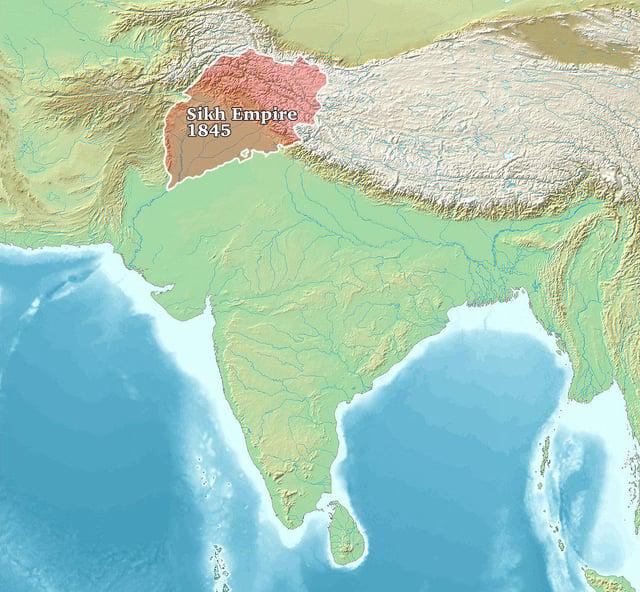Sikh Empire 1845 Map


David Chen
Data Visualization Specialist
David Chen is an expert in transforming complex geographic datasets into compelling visual narratives. He combines his background in computer science ...
Geographic Analysis
What This Map Shows
The "Sikh Empire 1845 Map" provides a detailed overview of the territorial expanse of the Sikh Empire at its zenith. Spanning parts of present-day India and Pakistan, this map illustrates not only the political boundaries but also the geographical features that defined this remarkable empire. Encompassing regions like Punjab, parts of Kashmir, and the northwestern frontier, the map serves as a historical record of the Sikh Empire's influence and territorial claims during the mid-19th century.
Deep Dive into the Sikh Empire
The Sikh Empire, founded in the early 19th century by Maharaja Ranjit Singh, represented a significant chapter in the history of the Indian subcontinent. At its height, the empire was marked by a rich tapestry of culture, religion, and military prowess. The map allows us to appreciate the geographical context of this vast empire, which was characterized by its strategic location along critical trade routes and its diverse demographic landscape.
Interestingly, the empire was not just a political entity but a melting pot of various cultures, languages, and religions. The predominant group was, of course, the Sikhs, but there were also significant populations of Hindus and Muslims. This diversity was reflected in the cities and towns that flourished under Sikh rule, such as Lahore and Amritsar, which became centers of commerce and spirituality.
The Sikh Empire was renowned for its military strength, which was bolstered by its advanced artillery and disciplined army. The empire's territory included fertile plains, making it an agricultural hotspot, which contributed to its wealth and stability. This agricultural abundance is a notable feature that ties into the geographical aspects of the region, as the Indus River and its tributaries provided essential irrigation for crops.
Furthermore, the map indicates the empire’s mountainous borders to the north and west, which played a crucial role in defense against invasions. The rugged terrain of the Himalayas and the Khyber Pass significantly influenced military strategies and trade dynamics. Have you ever wondered why certain empires thrived while others faded away? Geography often played a pivotal role in these outcomes.
Regional Analysis
Breaking down the Sikh Empire by regions shown in the map reveals significant variations in culture, economy, and demographics. In the fertile plains of Punjab, agriculture thrived, producing wheat and rice, which not only fed the local population but also became crucial for trade. Punjab was the heartland of the Sikh community and the site of major religious sites like the Golden Temple in Amritsar, a cornerstone of Sikh culture and identity.
In contrast, the territories in the northwest, bordering Afghanistan, were characterized by a more tribal society. Regions like Peshawar and the Khyber Pakhtunkhwa were less influenced by centralized authority and more by local tribal dynamics. This variation illustrates how geography influenced social structures and governance within the empire.
Interestingly, the empire's expansion into Kashmir brought it into contact with different cultures and resources. The lush landscapes of Kashmir were not only a strategic asset but also a cultural melting pot where Persian influences mingled with local traditions, enriching the empire’s cultural fabric.
Significance and Impact
The Sikh Empire's significance extends beyond its temporal existence. It laid the groundwork for contemporary Sikh identity and influenced the political landscape of South Asia. The historical boundaries depicted in the map can still be seen in modern geopolitical issues, as the regions once controlled by the Sikh Empire remain vital to India-Pakistan relations today.
Moreover, the legacy of the Sikh Empire is evident in the cultural and religious practices that continue to thrive in the region. The map serves as a reminder of the rich history that has shaped the identities of millions and highlights how historical empires have lasting impacts on contemporary society. As we look forward, understanding the geographical context of such empires can help us navigate current trends and projections, particularly as discussions about regional autonomy and cultural preservation continue to evolve.
In conclusion, the "Sikh Empire 1845 Map" is not just a reflection of territorial boundaries but a gateway to understanding the complex interplay of geography, culture, and history that defines this fascinating period.
Visualization Details
- Published
- October 7, 2025
- Views
- 52
Comments
Loading comments...